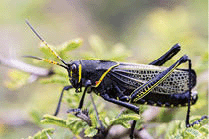Return to 2nd Quarter 2021 articles.



This grasshopper cannot fly, and it can barely jump. The western horse lubber grasshopper (Taeniopoda eques) protects itself by eating.
Western horse lubber grasshoppers live in the arid Sonoran area of the southwestern United States and Mexico. They are larger than the average grasshopper at 2.75 inches (7 cm) long. Despite being a large morsel, they can sit on a bush in the desert and relax, knowing that predators will leave them alone. Their defense is that they eat toxic plants, which give them a nasty taste for any animal foolish enough to eat them.
To warn a potential predator that it does not taste good, horse lubber grasshoppers have distinctive colors with a shiny black body and yellow trim. Besides being a warning to predators, the black body also provides thermoregulation. On cold days, the black color absorbs heat, which speeds the metabolism of the insect. Without this thermoregulation, the horse lubber grasshopper would not survive in the northern portion of its range. It orients and positions its body to maximize sun exposure in the cool part of the day and then finds shade during the day's heat.
Horse lubber grasshoppers also produce a warning odor made from chemicals derived from the plants they eat. If a mouse threatens the grasshopper, it sprays the foul-smelling chemical and makes a hissing sound. It may also expose its bright red hind wings and wave its legs and antennae. A predator who is not smart enough to back off but eats the grasshopper instead will become sick or possibly die.
There is a fantastic variety of defense mechanisms used by the millions of creatures God has designed.
Picture credits:
© Denise Campbell. Image from Big Stock.com.
